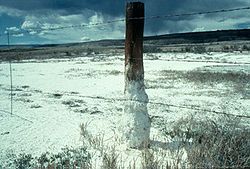soil with relatively low levels of soluble salts and a concentration of sodium high enough to adversely affect soil structure (symptoms include waterlogging. erosion. soil surface crusting. and poor plant growth). Soils > 12 SAR (see sodium absorption ratio).
sodic soil (Wikipedia)
Soil salinity is the salt content in the soil; the process of increasing the salt content is known as salinization. Salts occur naturally within soils and water. Salination can be caused by natural processes such as mineral weathering or by the gradual withdrawal of an ocean. It can also come about through artificial processes such as irrigation and road salt.


